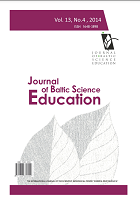TURKISH MIDDLE SCHOOL STUDENTS’ CONCEPTIONS AND MODELLING OF CHEMICAL BONDS
TURKISH MIDDLE SCHOOL STUDENTS’ CONCEPTIONS AND MODELLING OF CHEMICAL BONDS
Author(s): Aytekin Cokelez, Burçkin Dal, Gonca HarmanSubject(s): School education, Educational Psychology, 17th Century, 18th Century
Published by: Scientia Socialis, UAB
Keywords: chemical bond; intermolecular bond; intramolecular bond; model; modelling; science education;
Summary/Abstract: The purposes of this study were to identify students’ conceptions of chemical bonds and to determine, after instruction, the changes these conceptions undergo. The dataset for this study arises from an administered questionnaire that includes answers to three open–ended questions from 76 6th grade students and 56 7th grade students. Analysis of the qualitative data obtained through the questionnaire indicates that the majority of students had difficulty comprehending the modelisation of chemical bonds and that levels of interpreting these concepts of chemical bonds was much lower than what is required at the end of these different grades. The study showed that students have similar conceptions of bonding affinity expressed though a language of kinship and convenience, as used in 17th century. Additionally, the students’ conceptions also reflect the 18th century’ macro level concept of affinity expressed through the notion that likes attract.
Journal: Journal of Baltic Science Education
- Issue Year: 13/2014
- Issue No: 4
- Page Range: 483-496
- Page Count: 14
- Language: English

